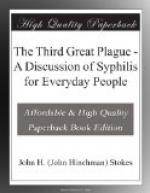[9] Iglesheimer, quoted by Derby.
Blindness in hereditary syphilis may, of course, take the same form that it does in the acquired disease, resulting from changes in the nerve of sight (optic nerve). This form is entirely beyond help by treatment.
+Ear Trouble—Nerve Deafness.+—The second important complication of hereditary syphilis is deafness. This occurs from changes in the nerve of hearing and may be present at birth or may come on many years later. The deaf infant is usually recognized by its failure to learn to talk, although it may seem perfectly normal in every other way. Again, the child may hear well at birth and deafness may come on in later life,—as late as the twentieth year,—suddenly or gradually, and become complete and permanent. It is often ascribed to colds or to falls and accidents that happen to occur at the same time. If syphilitic deafness comes on before the age of ten years, it is very apt to result in the child’s forgetting how to talk, and becoming dumb as well. It goes without saying that children whose syphilis made them deaf at birth never learn to talk at all, and are therefore deaf and dumb. Very little is known about how many of the inmates of asylums for the deaf are hereditary syphilitics, but there is reason to suspect the percentage to be rather large. Deafness in hereditary syphilis is practically uninfluenced by treatment.
+Accident and Injury in Hereditary Syphilis.+—It is a matter of great importance to realize the large part played by accidents, injury, poor health, or lowered resistance in bringing a hidden hereditary syphilis to the surface. A child may show no special signs of the disease until some time during its childhood it has a fall which injures or bruises a bone or breaks a limb. Then suddenly at the place where the injury was done a gumma or tertiary syphilitic change will take place and the bone refuses to heal or unite or a large sore may develop which may be operated on before the nature of the condition is realized. In the same way a woman with hereditary syphilis may seem in perfect health, marry, and suddenly after the birth of her first child, even as late as her twenty-fifth year, may develop syphilitic eye trouble. It must be realized that hereditary syphilis is as treacherous as the acquired disease, and can show as little outward signs before a serious outbreak. It is part of the duty of every person who suspects syphilis in his family or who has it himself to let his physician know of it, for the sake of the help which it may give in recognizing obscure conditions in himself or his children.




